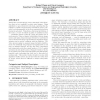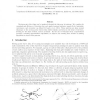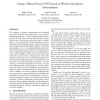191
Voted
GIS
2004
ACM
16 years 1 months ago
2004
ACM
Triangular Irregular Network (TIN) and Regular Square Grid (RSG) are widely used for representing 2.5 dimensional spatial data. However, these models are not defined from the topo...
204
click to vote
GIS
2004
ACM
16 years 1 months ago
2004
ACM
Modern database applications including computer-aided design, multimedia information systems, medical imaging, molecular biology, or geographical information systems impose new re...
178
Voted
GIS
2004
ACM
16 years 1 months ago
2004
ACM
This paper discusses a variety of ways to place diagrams like pie charts on maps, in particular, administrative subdivisions. The different ways come from different models of the ...
234
Voted
GIS
2004
ACM
16 years 1 months ago
2004
ACM
This paper presents a fast algorithm for smooth digital elevation model interpolation and approximation from scattered elevation data. The global surface is reconstructed by subdi...
193
Voted
GIS
2004
ACM
16 years 1 months ago
2004
ACM
Aerial video provides strong cues for automatic road extraction that are not available in static aerial images. Using stabilized (or geo-referenced) video data, capturing the dist...
186
Voted
GIS
2004
ACM
16 years 1 months ago
2004
ACM
In the geometric data model [6], spatio-temporal data are modelled as a finite collection of triangles that are transformed by time-dependent affinities. To facilitate querying an...
203
Voted
GIS
2004
ACM
16 years 1 months ago
2004
ACM
Moving point object data can be analyzed through the discovery of patterns. We consider the computational efficiency of detecting four such spatio-temporal patterns, namely flock,...
177
Voted
GIS
2004
ACM
16 years 1 months ago
2004
ACM
Recent growth of the geospatial information on the web has made it possible to easily access various maps and orthoimagery. By integrating these maps and imagery, we can create in...
162
Voted
GIS
2004
ACM
16 years 1 months ago
2004
ACM
198
Voted
GIS
2004
ACM
16 years 1 months ago
2004
ACM
The advances in wireless communication and decreasing costs of mobile devices have enabled users to access desired information at any time. Coupled with positioning technologies l...




